
Alum Lee Magpili turns lifelong passion into career as designer at LEGO Group




Alum Lee Magpili turns lifelong passion into career as designer at LEGO Group


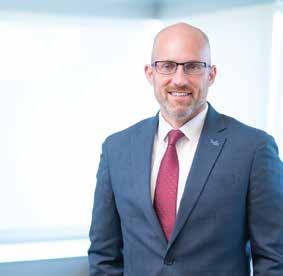
CHANGE IS AT THE HEART OF ENGINEERING. Our exploration of the unknown in search of innovative solutions is the catalyst for every discovery and breakthrough. In the School of Engineering and Applied Sciences, we recognize that change is something to be embraced as an opportunity for growth and progress.
One of the greatest changes facing our society is the evolution of artificial intelligence and its integration into our daily lives. Our university is positioned at the forefront of this revolution, having recently been chosen as the home for Empire AI, New York State’s $400 million consortium that will advance fundamental AI research and innovation for social good. SEAS researchers are tapping into AI and other technologies to transform medical imaging and diagnostics, reshape the sustainability of indoor farming, strengthen critical infrastructure, and more.
Our school is undergoing change as well. SEAS is growing rapidly in enrollment, research and impact This year, we welcomed34 new faculty, eclipsed $100 million in research expenditures, and enrolled nearly 7,900 students. We also broke ground on the construction of Agrusa Hall, our new signature building and hub for experiential learning and innovation that is supported by a historic gift of $40 million from alum and benefactor Russell L. Agrusa.
Throughout these pages, we showcase a few of the ways that members of our SEAS community have made groundbreaking discoveries, commercialized new technologies, delivered transformative education, and ventured into uncharted territory to shape solutions to global challenges.
We welcome and embrace the opportunity to leverage our strengths to change the conversation around solving society’s most pressing problems.
Together, we are SEAS. Together, we are UB.
The magazine for alumni and friends of the UB School of Engineering and Applied Sciences.
SCHOOL LEADERSHIP
Kemper Lewis, Dean
Jeffrey Errington, Senior Associate Dean for Academic Affairs
Rajan Batta, Associate Dean for Faculty Affairs and Recognition
Kevin Burke, Associate Dean for Student Affairs
Kristen Moore, Associate Dean for Equity and Inclusion
Nathaniel Wills, Unit Business Officer
Jun Zhuang, Associate Dean for Research
DEPARTMENT CHAIRS
Francine Battaglia, Mechanical and Aerospace Engineering
Jonathan Bird, Electrical Engineering
Robert Dell, Industrial and Systems Engineering
David Doermann, Computer Science and Engineering
James Jensen, Engineering Education
Alan Rabideau, Civil, Structural and Environmental Engineering
Krishna Rajan, Materials Design and Innovation
Mark Swihart, Chemical and Biological Engineering
Yun Wu, Biomedical Engineering
ENGINEERING ALUMNI ASSOCIATION OFFICERS
Nate Bolt, President
BS ’11
Jordan Walbesser, Immediate Past President
JD ’10, BS ’07
Tim van Oss, Vice President MS ’16, BS ’14
Briana Tom, Secretary
MBA ’17, BS ’17
Anthony Marchisiello, Treasurer
MBA ’17, BS ’17
Alissa Drag, SEAS Liaison
EDITOR
Marcene Robinson
CONTRIBUTING WRITERS
Charles Anzalone, Tom Dinki, Sarah D’Iorio, Mary Durlak, Elizabeth Egan, Jacqueline Molik Ghosen, Laurie Kaiser, Peter Murphy, Cory Nealon
DESIGN
Green Soup Design, Carly Pinter
PHOTOGRAPHY
Sarah D’Iorio, Elizabeth Egan, Meredith Forrest Kulwicki, Douglas Levere, Blanc Photographie, Onion Studio, Inc.
SUPPORT OUR SCHOOL


Kemper Lewis,
Your philanthropic support helps to fund a variety of student programs. Please visit buffalo.edu/campaign/ seas to make your contribution. Your participation at any level is appreciated.
ADDRESS CHANGES
UB Alumni can update their address through UB Connect: ub-connect.com
All others can email seascomm@buffalo.edu or clip the address label and return itwith the correct address to: Buffalo Engineer, School of Engineering and Applied Sciences, University at Buffalo, 438 Bell Hall, Buffalo, NY 14260
42,000+
4,898






by
THE UNIVERSITY AT BUFFALO’S VISION of 21stcentury engineering—collaborative, innovative, entrepreneurial and exciting—is transitioning from a concept to concrete reality. Embodied through stone, steel and glass, the new engineering and applied sciences building will serve as a hub for student learning and activity where leadership and curiosity are nurtured.
The endeavor is made possible, in part, through a historic gift of $40 million to the School of Engineering and Applied Sciences by longtime benefactor and alum, Russell L. Agrusa (BS ’76). The donation is the largest single contribution by an individual in school history.
Half of the donation—$20 million—is designated to the new building on the North Campus, which will be named Russell L. Agrusa Hall. The remainder
will be allocated for the advancement of engineering and applied sciences education. The gift was also the final push to help the UB Boldly Buffalo fundraising campaign achieve its $1 billion goal.
On September 17, the university welcomed public officials and community members to a groundbreaking ceremony in the Furnas parking lot, the future location of Agrusa Hall.
“My hope for this project is to change lives,” said Agrusa, the founder and retired CEO of ICONICS Inc. who also has been a member of the Dean’s Advisory Council since 2003. “It’s not just a space for engineering students. We’re purposely creating an environment where students from all disciplines can collaborate. Something this large needs to be a hub that will bring people together.”

The new building—expected to cost roughly $111 million—will be uniquely student-focused and will accommodate the continued growth of SEAS, where enrollment has surged to more than 7,500 students, up 46% from 2013. Agrusa Hall will house the Department of Engineering Education and collaborative spaces for student clubs and hands-on learning.
During the groundbreaking ceremony, UB President Satish K. Tripathi remarked on the transformative impact that Agrusa Hall will have on the university community
“Consider the collaborations that will form there and contribute to economic prosperity and vitality in the region, state and well
beyond; the students who will be educated there and go on to lead in their fields; the innovations that will take root there, producing the technologies of tomorrow,” said Tripathi.
Dean Kemper Lewis added that Agrusa Hall “will be a welcoming and supportive space for all students, and it will serve as a central gathering point where they are inspired to pursue their intellectual curiosities and develop innovative solutions for society’s greatest challenges.”



THE SCHOOL OF ENGINEERING AND APPLIED SCIENCES recently made two new additions to its advancement and alumni engagement team: Alissa Drag, assistant director of alumni engagement, and Matthew Fratto, senior director of advancement. Together, they will strive to build strong connections with our alumni and donors across the world.
As new members of the SEAS Community, they each shared what they’re most excited about in their roles:
“We have over 42,000 accomplished grads—I’m working to showcase their achievements and help them stay connected with each other and with SEAS. I’m excited to rally our global alumni network to build a lively, supportive community that celebrates our shared successes and paves the way for future ones. Let’s make it happen!”
—Alissa Drag
“It’s an exciting time at SEAS with its continuous growth in research, facilities and students. I most look forward to building relationships with our alumni, faculty and staff, and working with these groups to grow the momentum that is building on campus. It’s a privilege to be on the SEAS team!”
—Matthew Fratto
Connect with SEAS and your former classmates.


Chair, Department of Chemical and Biological Engineering
Jeffrey Errington, Professor*

Chair, Department of Computer Science and Engineering
David Doermann, SUNY Empire Innovation Professor

Chair, Department of Industrial and Systems Engineering
Robert Dell, Professor

Associate Dean, Office of Academic Affairs
Luke Ziarek, Department of Computer Science and Engineering*

Associate Dean, Office of Research Advancement
Jun Zhuang, Department of Industrial and Systems Engineering

Associate Dean, Office of Student Affairs
Kevin Burke, Department of Electrical Engineering
*Appointment effective January 1, 2025.
IN THE 1990S, A TEAM OF COMPUTER SCIENTISTS at the University at Buffalo delivered one of the first practical success stories of artificial intelligence: development of a handwriting recognition system for the U.S. Postal Service. The technology, at the time cutting-edge, has saved the agency billions of dollars in operational costs.
Gov. Kathy Hochul announced in January that UB will serve as the epicenter of a $400 million statewide consortium called Empire AI.
NEW YORK GOV. KATHY HOCHUL ANNOUNCES UB AS THE HOME FOR EMPIRE AI.
Their work, through the Center of Excellence for Document Analysis and Recognition, or CEDAR, established UB as a groundbreaker in artificial intelligence research. Today, UB researchers continue to push the capabilities and the applications of AI.
Their work hasn’t gone unnoticed. New York State
The consortium will create a tech hub where public and private research institutions across the state can together leverage the vast possibilities of artificial intelligence, all with a singular aim of solving societal challenges both large and small. The initiative also includes the construction of a new state-of-the-art computing center on UB’s campus to power innovation across the state.
With UB leading the way, Empire AI aims to place New York at the forefront of the AI revolution.

1
GIVING STEM CELLS NEW LIFE
Over 95% of stem cells die after being injected into the brain. Stelios Andreadis, Department of Chemical and Biological Engineering, is co-leading the development of a solution to protect the cells: shear-thinning hydrogels. Supported by the National Institutes of Health, the technology could improve therapies for neurological disorders.
2
Teng Wu, Department of Civil, Structural and Environmental Engineering, is supporting the creation of new wind hardening technologies that could allow solar energy systems to withstand the force of hurricanes. Funded by the U.S. Department of Energy, the project could increase energy production and drive down maintenance costs.
3
WOOD CHIPS TO GREEN HYDROGEN
R h enewable wood chips can be a source of green ydrogen with carbon capture, though require high-purity oxygen for combustion. Supported by the U.S. Department of Energy, Haiqing Lin, Department of Chemical and Biological Engineering, is leading an investigation that aims to create a “magical” membrane that separates oxygen from nitrogen.
4
DAMPENING THE INEQUALITY OF WILDFIRE
Wildfires are becoming more frequent and severe and disproportionately impact low-income communities. Sayanti Mukherjee, Department of Industrial and Systems Engineering, is leading research supported by the National Science Foundation to bridge this chasm. The project aims to improve wildfire emergency management of infrastructure systems and connect vulnerable residents with resources.
5
SHARPENING MEDICAL IMAGING WITH AI Mingchen Gao, Department of Computer Science and Engineering, is harnessing the power of artificial intelligence to help doctors better diagnose disease. Supported by a National Science Foundation CAREER Award, Gao is leading the development of AI tools that detect subtle signs in medical imaging, helping physicians catch life-threatening diseases early
6
FORGING SPACE TECH FROM EARTH’S THINNEST MATERIALS
Paras Prasad, Department of Electrical Engineering, is leading the design of space technology from 2D materials, the thinnest materials on Earth that consist of a single layer of atoms. Funded by the Air Force Office of Scientific Research, the technology will advance satellites sensors, cosmic radiation shields and more.
7
Matilde Sánchez-Peña, Department of Engineering Education, is leading a project supported by the National Science Foundation to explore the complex dynamics of policies implemented to support the advancement of women faculty in engineering during the last 20 years, and why, despite intentions, the gender gap in the field remains unchanged.
8
MAPPING THE BRAIN WITH OXYGEN
Junghun Cho, Department of Biomedical Engineering, is developing new technology that measures how much oxygen is gobbled up by our cells. Supported by the National Institutes of Health, the research would study the causes of and treatments for neurological disorders like dementia, focusing on abnormal cell oxygen usage.
9
RESTORING DISRUPTED POWER GRIDS WITH AI
Souma Chowdhury, Department of Mechanical and Aerospace Engineering, is guiding the creation of artificial intelligence models that prevent power outages by automatically rerouting electricity in milliseconds, allowing power grids to “self-heal” without significant human intervention. The project is supported by the U.S. Office of Naval Research and National Science Foundation.
10
ACCELERATING THE CLEAN ENERGY TRANSITION
The university has formed a new clean energy research hub, the Center for Accelerated Innovation through Materials, which will merge materials science, artificial intelligence and advanced manufacturing. The center is supported by the National Institute of Standards and Technology and led by Krishna Rajan, Department of Materials Design and Innovation.

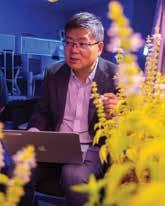
INSIDE A NONDESCRIPT COMPUTER LAB at the University at Buffalo, a new tech-savvy style of indoor farming is blossoming.
Lettuce and basil are growing inside a phonebooth-sized greenhouse, all under the unflinching eyes of an artificial intelligence system designed to identify the faintest signs of sickness and distress among the plants.
The early detection of nutrient deficiencies, pests and other problems, as well as the optimization of LED lighting, are the crux of a new research project at UB’s Institute for Artificial Intelligence and Data Science.
“There is so much potential for using AI and computer vision, especially in a
controlled environment such as an indoor farm. It’s really a great example of using AI in an innovative way to address societal needs,” says the institute’s director Jinjun Xiong, SUNY Empire Innovation Professor in the Department of Computer Science and Engineering.
Indoor vertical farming typically uses less water and land than traditional farming. Crops can also be grown closer to where they’ll be sold to consumers, including communities where access to fresh, healthy food is lacking. All make for a potentially more sustainable model of agriculture, especially as climate change disrupts outdoor farming.
But the industry still has its challenges, most prominently the cost of monitoring plant health. A challenge the UB project aims to address.
Partners in the effort include Ellicottville Greens and Buffalo-based Starco Lighting. The research is supported by a grant from nonprofit FuzeHub.
THE SCHOOL OF ENGINEERING AND APPLIED SCIENCES attracts some of the world’s brightest young researchers to the Buffalo Niagara region. This year, eight SEAS junior faculty have earned National Science Foundation (NSF) CAREER Awards, the NSF’s most prestigious honor for early-career faculty.








Courtney Faber Engineering Education
Andrew Olewnik Engineering Education
Craig Snoeyink Mechanical and Aerospace Engineering
Kang Sun Civil, Structural and Environmental Engineering
Yinyin Ye Civil, Structural and Environmental Engineering
Zhuoyue Zhao Computer Science and Engineering
Luis Herrera Electrical Engineering Shaofeng Zou Electrical Engineering
BRIAN BISCHOFF (BS ‘15) BELIEVES IN COPPER INK.
In 2022, he founded his copper ink startup, Copprium Inc., to challenge the multibilliondollar conductive ink market currently dominated by silver.
Yet Bischoff says the venture would not be possible without the University at Buffalo.
Not only was Copprium’s patented technology developed in the lab of former mechanical and aerospace engineering faculty member Shenqiang Ren, but the university also provided startup funding and space, as well as ongoing support and guidance. The company is a spin-out from UB’s Business and Entrepreneur Partnerships, and several university offices have helped Bischoff purchase equipment, hire staff, manage payroll, file for patents and trademarks, and incorporate.
“Without UB, it would be too risky to even try,” says Bischoff, Copprium’s president. “The initial investment needed to start a company like this is just not feasible for the average entrepreneur. So, it’s a win-win all around: We get support to grow our company and UB’s technology hopefully goes to the marketplace.”
Conductive ink is used to print electrical pathways on various surfaces—whether it be paper, plastic, fabric or even glass—and can be found in solar panels, car components and medical devices. Copper ink holds several advantages, including being more abundant and cheaper than silver ink.
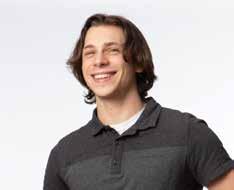


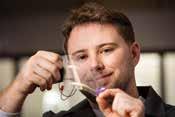

company is sharing free samples of its products with customers for feedback and aims to raise capital through investors.
DOMINIC LAVIGNE, a mechanical engineering student, earned second place in UB’s Henry A. Panasci Jr. Technology Entrepreneurship Competition for the startup he co-founded,
Exergi, which develops solar energy generators powered by micro steam turbines. The achievement earned LaVigne inclusion in Buffalo Inno’s latest 5 Under 25 list.

HARSHITA GIRASE (BS ’19) is the founder and host of Founders Without Borders and a senior analytics engineer at Sigma Computing.
Tell us about Founders Without Borders.
Founders Without Borders is a podcast I started in 2023 that highlights the journeys and stories of immigrant founders building generational businesses.
What inspired you to create Founders Without Borders?
I am an immigrant myself and I have watched many of my immigrant friends attempt to start companies. Starting a company is super hard on its own. Add navigating visas, the lack of financial support, and the lack of emotional support, and it’s all the more challenging.
After I moved to San Francisco, I met more immigrants who had taken the leap of faith and started their businesses. Each founder’s story was different, but they had all overcome similar barriers just to start a company. I wanted to share these stories with the world. To my surprise, there wasn’t much media highlighting these stories, so I decided I was going to be the one to do it.
You also work as a senior analytics engineer. What do you like most about your role?
I work on the data team at Sigma Computing, so we collaborate with all other teams within the company—engineering, marketing, revenue, sales, you name it. I think the collaborative nature of it is what’s really exciting. Our team gets to understand the different parts of the company and bridge the gap between the business teams and the technical teams, while providing data to help answer questions and inform decisions.
What advice would you give to UB students who want to be entrepreneurs?
Just do it. Do it sooner rather than later, because it’s very hard and it’ll suck up a lot of energy. If you realize a few years down the road that you’re not happy, it’s fine. You are still employable and have a good degree.
Reaching out to people who’ve done it is always helpful as well. There are the UB incubators and the Startup and Innovation Collaboratory on campus. The school has resources. You just have to be a little bit more proactive and go after it.
Is entrepreneurship in your future?
I do want to start a company at some point. I want to find a problem that I’m passionate about. I would love to just make a small dent in the world and have an impact.
Listen Now: Find the Founders Without Borders podcast on Spotify and Apple Podcasts.
SUBIR PARULEKAR
(MS ’04) works in an industry that touches the lives of billions of people worldwide—streaming.
Parulekar is the senior director of engineering for the Walt Disney Company, which offers Disney+, ESPN+, Hulu and Star+.
By Elizabeth Egan

For over a decade, he has worked for Netflix and Disney, helping develop platforms that deliver countless hours of entertainment. A career that he prepared for as a student at the University at Buffalo, where he gained the education, experiences and values that continue to guide him to this day.
Parulekar set out from India to find a graduate program in the United States after completing his bachelor’s degree in computer science. UB’s strong computer science program and affordable tuition made it a perfect fit.
Coming to UB without financial aid, Parulekar held several part-time jobs until securing a research assistantship at UB’s Center of Excellence for Document Analysis and Recognition (CEDAR). There he worked under CEDAR’s late founder, Sargur Srihari, a renowned researcher, and SUNY Distinguished Professor Venu Govindaraju, now UB’s vice president for research and economic development.
“My time at UB gave me a good taste of real-world experience and taught me the value of hard work,” said Parulekar. “The lessons I learned in those two years have remained with me through my career,
reminding me that whatever you are doing, you have to put in the hard work and that is what gets you to the next level.”
Parulekar recalled an algorithms class that was particularly valuable, noting that algorithms play a key role in his work in streaming.
“We use algorithms in code implementations to figure out the most performant approach for the features we build into applications,” said Parulekar. “This helps with scalability because when a platform has millions of users, performance of the applications matters quite a bit.”
While at UB, Parulekar also met his wife, Swapna Kulkarni, who was a student in the School of Architecture and Planning.


My time at UB gave me a good taste of real-world experience and taught me the value of hard work.”
Subir Parulekar (MS ’04)
After graduation, Parulekar worked in multiple software development roles and cofounded a startup called Socially Referred with two friends.
“The vision was to move away from faceless reviews of service providers on sites like Yelp, leveraging the power of your social network to get trusted referrals and reviews,” said Parulekar.
While his visa restricted his ability to work at a startup full time, he said that he is proud to have realized his vision and create something from scratch.
In 2013, Parulekar joined Netflix, working to help transition the billing and payment engineering systems from the data center to the cloud. Later during his tenure at Netflix, Parulekar became the engineering manager in charge of promotional videos and trailers and adtech engineering. In 2020, he moved to Disney, just two months after the launch of Disney+.
While Disney+ and Hulu are some of the biggest streaming services in the U.S., Parulekar said that the streaming side of
PARK, BOTTOM LEFT; AND SMILES WITH UB PRESIDENT SATISH K. TRIPATHI, BOTTOM RIGHT. PHOTOS COURTESY OF SUBIR PARULEKAR.
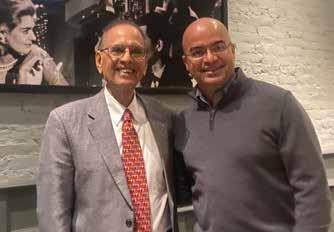
Disney still moves at the speed of a startup.
Parulekar’s team powers the signup experience for Disney’s four streaming services. He also supports the Disney+ tiers that launched internationally last year, currently reaching over 150 countries.
When Parulekar started at Netflix, people were still learning what a streaming platform was supposed to have, he says. Today, one of his jobs is meeting the expectations that customers have developed over the past decade of what a streaming service should include.
“Streaming services are supposed to have a lot of features and we are fairly new,” said Parulekar. “In my position, the biggest challenge is how we migrate to newer technologies while working on various business initiatives. It is almost like changing the engine of a plane while it is flying and making sure you land without delays in the most cost-effective way possible.”
On top of the challenge of keeping up with existing streaming standards, such as letting users continue watching from any device and live streaming, they also must be forward-thinking to create new features
and ensure their technology does not become limiting as the service expands.
After a long career in industry, Parulekar said he is thinking about ways that he can help share his experiences with UB students and alumni. He hopes to return to UB to visit his former teachers and speak with computer science students.
For students aspiring to grow into leadership positions, Parulekar shared three quick lessons that he has learned during his career.
Learn to motivate people and lead by example. You need an army of people to achieve your goal.
If you take something on, solve it to completion. This helps you build trust and respect.
Never stick to one thing. Gain diverse experiences and broaden your perspective.
By Peter Murphy

OLIVER KENNEDY’S life changed when a friend dragged him into a sword fight. The swords were real, but every move during the clash was staged.
He had previously explored fencing, but this distinct style of combat would open a new world and help him forge lifelong connections.
Kennedy is an associate professor of computer science and engineering. His research focuses on databases and the uncertainty of data. Although his hobby and his career in academia do not overlap, Kennedy says there are some indirect connections.
“I feel like stage combat has done a lot to make me a better instructor and presenter. Like many computer scientists, I tend towards the introverted end of the spectrum,” Kennedy says. “Getting on stage and performing a fight forced me to learn how to ride the adrenaline of dozens or hundreds of people staring at my every move, instead of being petrified.”
Kennedy joined New York University’s (NYU) varsity fencing team while working toward his bachelor’s degree. He enjoyed the sport but admits he lacked the skill to excel.
“I wasn’t very good,” Kennedy says. “During that time, I also joined the local chapter of the Society for Creative Anachronism’s competitive fencing group. Here, I was much better.”
The Society for Creative Anachronism (SCA) is an immersive history group that recreates the Middle Ages and Renaissance period through themed clothing and experiences, including competitive fencing. Kennedy was an active member throughout
OLIVER KENNEDY (LEFT) AND CHRISTINA ROCKWELL (RIGHT) POSE WITH THEIR DAGGERS AND RAPIERS AT THEIR WEDDING.
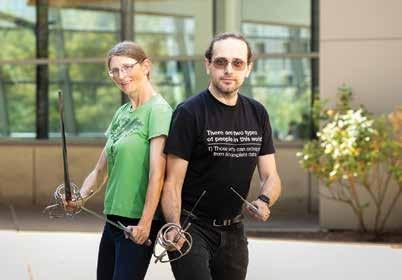
his time at NYU and searched for an SCA group in Ithaca, New York when he started a graduate program at Cornell University.
“Fencing was my gateway drug. When I got to Cornell, a fellow student found out about my efforts to track down the local SCA and started trying to get me to join this choreographed sword-fighting group he was a part of,” Kennedy says. “He dragged me to a Ring of Steel practice, and I got hooked.”
“It’s a fantastic martial art and an intensely collaborative activity with a really fun group of people,” he continues. “And, of course, there was the cool factor.”
Ring of Steel provides training in theatrical combat and stunts. Its members— Ringers—use real swords in choreographed fights. Ringers master scripted bouts with room for improvisation depending on performance or audience. Once, during a half-time performance at a roller derby bout, Kennedy added a flourish to a Shakespeare production.
“My wife and I performed the Hamlet vs. Laertes fight from “Hamlet,” but we added a crotch kick,” he says. “It was hard to do that tastefully.”
Kennedy formed several relationships through Ring of Steel, including one that blossomed off the stage. He and his wife, Christina Rockwell, met through the group, and the time that they spent together helped foster a friendship that evolved into romance. The couple’s shared interest in sword fighting would help them maintain their relationship despite living far away
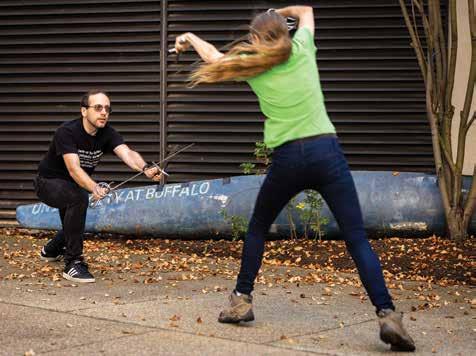

PERFORMING FIGHTS HELPED OLIVER KENNEDY HONE HIS SKILLS AS AN INSTRUCTOR AND PRESENTER.
from each other, sometimes on different continents.
He proposed during a Ring of Steel reunion.
Kennedy suggested to her that they practice a familiar duel that happened to include a move where he drops down to one knee. During the exchange, he dropped to his knee, but stopped and asked Rockwell to marry him.
He would ask Andrew Cunningham, the friend who dragged him to his first Ring of Steel practice, to be his best man.
“Our wedding, like several other Ringer marriages, featured a first fight instead of a first dance,” Kennedy says.
“Ring of Steel: Ithaca alumni are a tight knit group, even across several generations of the club,” he continues. “One of the
appeals of the group is that since a lot of the core fights are standardized, two people who have never met before can run through a fight with little or no prep, sort of like two dancers. It’s a great way to build bonds.”
Kennedy is not as involved in the hobby as he was in college. He and Rockwell still attend a few practices every year, and the couple will perform fights for friends or family. Kennedy frequently picks up a practice sword to help focus his thoughts or destress.
“At this point, the hobby is sort of in maintenance mode,” Kennedy says. “It’s a shame, but I, unfortunately, don’t fight with my wife more often, particularly since the birth of our son.”
Kennedy is working to establish a stage combat group, albeit informal, at UB. He and fellow computer science and engineering faculty member Matthew Hertz, who has SCA experience, held practice sessions over the summer and hope to organize more.
Anyone in the Buffalo area who is interested in learning choreographed sword fighting may reach out to Oliver Kennedy at okennedy@buffalo.edu

By Sarah D’Iorio
EVERY ASPIRING ENGINEER is familiar with the requisite math, physics and chemistry courses that lay the foundation for a career in the profession. Now among the traditional roster of courses at UB, engineering students can also delve into the technology of craft beverages.
This class shows students how to use those skills and apply them to creating and manufacturing craft beverages.”
Maura Sepesy
First offered in 2018, “Beer, Wine, Spirits—Technology & Business of Craft Beverages” (CE 411) was developed by the Department of Chemical and Biological Engineering as an elective course that taps into the increasing popularity of the global craft beverage movement.
“Our faculty were discussing options of enticing undergraduate majors other than our own to enroll in chemical and biological engineering courses. Half-jokingly, I suggested we offer a class on beer brewing,” said Blaine Pfeifer, a professor in the department.
The idea took off. Since its launch, the course has become a popular elective, consistently filling seats and even convincing some participants to pursue internships and full-time careers in the craft beverage industry.
Once the new course was set in motion, the department enlisted the help of engineering consultant and adjunct faculty member Bob Kosobucki in developing the curriculum. Pfeifer
knew of Kosobucki’s longtime passion for beer and wine making.
“After researching what was being done at other universities, I discovered that craft beverage courses are typically focused on one type of beverage, such as beer, wine or cider, for an entire semester,” said Kosobucki. “What I decided to do differently with CE 411 was to cover other craft beverages—like kombucha, mead, sake, vinegar and distilled spirits—in addition to beer and wine.”
Kosobucki dedicates the first lesson to covering the effects of alcohol on the body and the responsible consumption of alcohol. Participants then learn how chemistry, food microbiology and engineering are all key elements of craft beverage processes. Students are also introduced to the financial and customer service aspects of running a successful craft beverage business.
Pfeifer, who took over teaching the course from Kosobucki in 2021, said the class often includes guest speakers and visits to local craft beverage businesses—including regular tours hosted by chemical engineering alum Matt Kahn (BS ’98), co-founder and president of Big Ditch Brewing Co.
“Buffalo is lucky to have many local options for beers, wines, and spirits, and you’ll find incredibly innovative twists on the traditional production process when you visit these establishments,” said Pfeifer.
After hearing about CE 411, Jenna Armband (BS ‘22) was intrigued by the significance of engineering applications in the beverage industry.
“Prior to taking this course, I was familiar with the craft beverage space but unaware of the details that go into fermenting or distilling the perfect beverage,” said Armband.
For one assignment, students are tasked with designing a beer recipe and presenting their creations to their classmates. The experience allows students to observe how small changes in a recipe can affect a beer’s characteristics of taste, aroma, mouthfeel and appearance.
“It was one of the first courses that encouraged me to conduct my own research on a topic and confidently present what I had learned,” said Armband.
Nearing graduation, Armband took a chance at further exploring her new passion and landed a summer internship at E. & J. Gallo Winery in Modesto, California. She planned on returning to UB to pursue her master’s degree in chemical engineering, but a full-time job opportunity arose that she couldn’t pass up.
Today, Armband works as a research associate at Gallo Winery, which is the largest familyowned winery in the United States and the largest exporter of California wines.
“Whether it’s hand-picking grapes with the viticulture team, bottling wines with the enology
team, or learning about off-notes present in wine with the sensory team, there is always the possibility to learn something new,” said Armband.
This fall semester, class is in session again and a new cohort of students is at the ready to learn how to engineer the perfect craft beverage. While Pfeifer is on sabbatical, Kosobucki is back to teaching the class alongside Maura Sepesy, an assistant professor of teaching.
Sepesy has had her fair share of experience in brewing beer, mead and wine; she even participated in the American Institute of Chemical Engineers’ Beer Brewing Competition in 2021 as a graduate student at Case Western Reserve University.
According to Sepesy, craft brewing is a problem well suited to chemical engineers because it involves chemical reactions, fluid mechanics and an understanding of how to scale up a process.
“This class shows students how to use those skills and apply them to creating and manufacturing craft beverages,” she said.
While the department currently only offers the course to engineering students, the hope is to expand the offering across the university. For now, Sepesy is excited to teach a class that is so hands-on and unique.
“I really enjoy teaching, so having a course that students are also excited to learn about makes it that much more fun,” said Sepesy.

DIRECTLY BELOW: ALUM JENNA ARMBAND ON THE JOB AT E. & J.
WINERY. BOTTOM: A TOUR AT BIG DITCH BREWING CO. LED BY CO-FOUNDER AND ALUM MATT KAHN ALLOWS STUDENTS TO SEE THE BEVERAGE MAKING PROCESS FIRSTHAND.




Alum
By Elizabeth Egan
MANY LEGO ENTHUSIASTS go through what Lee Magpili (BS ’03) calls a “dark age.” A time between childhood and adulthood when interest in building with the interactive toys fade. But for Magpili, his fascination carried over. From his childhood in the Philippines and the Bronx to being a student at the University at Buffalo and now a senior model designer at the LEGO Group, the colorful bricks have remained a significant part of Magpili’s life.
When his mother would bring back toys from the United States during his early childhood in the Philippines, all Magpili would ask for was LEGO. When he didn’t have a new LEGO set to build, he would occasionally see what else he could take a part and put back together, once taking a screwdriver to his Transformers. He rebuilt the toy successfully, an early sign of his aptitude for mechanical engineering that he would study years later.
An interest in space and a desire to get out of New York City led Magpili to UB. He was drawn to both
aerospace and mechanical engineering. Aerospace seemed like a “dream subject” with the potential for space travel, he explained, while mechanical felt more grounded.
“I was mesmerized by the mechanics of my toys and other objects growing up,” said Magpili. “I always wanted to know more about how they worked.”
Although he was interested in both subjects, Magpili admits that he had no idea what he would do with the degree.
LEGO remained a constant during his time in college—Magpili kept a three-foot-long LEGO Star Destroyer in his dorm room—but it would be years until he applied his UB education toward landing his dream job. However, Magpili did gain something unexpected at UB.
“Becoming a proud Filipino is something that I got at UB,” said Magpili, who was a member of the university’s Filipino American Student Association (FASA). “I really found the roots to my culture while in school.”
Going into college, Magpili knew that Greek life existed, but he did not expect the opportunity to explore more than 100 clubs and communities. As a


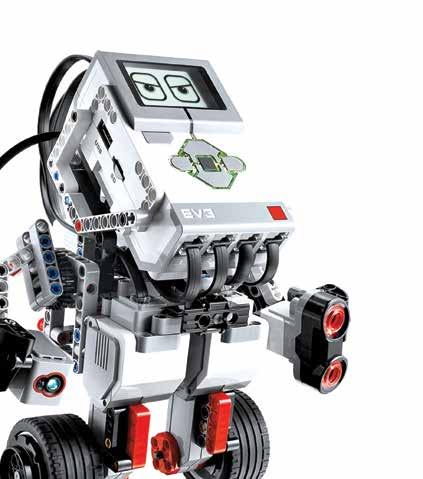



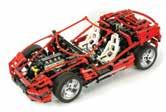
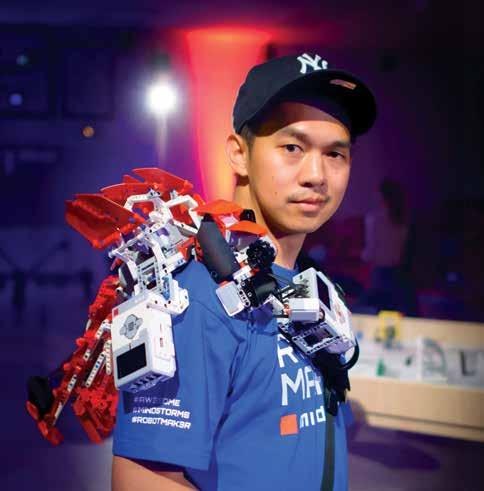

member of FASA, Magpili practiced martial arts and performed traditional Philippine dances. Having left the Philippines when he was five years old, his experiences at UB gave Magpili the opportunity to further explore what it meant to be Filipino.
Magpili credits his participation in different extracurriculars with helping him keep his life balanced outside of the classroom.
putting together small LEGO sets that he could base a lesson plan around.
In 2008, he became a coach for FIRST LEGO League, a worldwide robotics competition for kids age 6 to 16 that challenges them to solve real-world problems. Magpili enjoyed working with the students so much so that he decided to go back to school for a master’s degree in education.
So much of what I learned in my classes became a foundation of what I do today...”
Lee Magpili (BS ’03)
After graduating from UB, Magpili worked for the Department of Environmental Protection in New York City’s wastewater treatment plants. He said the experience was, “as smelly as it sounds.”
Hoping for a foot in the door at LEGO—and a better smelling work environment—Magpili got a job at the LEGO Store. He soon moved from selling LEGO sets to teaching LEGO robotics around Rockland County through the Lower Hudson Valley Challenger Center.
“It was a new platform at the time and a fun way to play with LEGO sets,” said Magpili. “I taught kids basic programming, building and robotics. I enjoyed finding out how they learned and watching the smiles on their faces when I made an activity fun for them.”
Magpili invented lessons from scratch, typically
Right as he was about to start, it happened: Magpili was offered his dream job—a position with the LEGO Group.
He said the decision was an easy one. He left school and relocated to Billund, Denmark, the home of the LEGO Group headquarters, where he remains today.
As a senior model designer at the LEGO Group, Magpili’s primary job is to design LEGO sets. However, he noted, there is no typical day in the life of a creative. On some days he is primarily staring at bricks, finding just the right piece that will work with his new model. After a design is completed, he must figure out how to convey the building process to his audience through instructions and box art.
When Magpili started the position, he designed sets that would never hit the shelves. Instead, he built sets for educational institutions and FIRST LEGO League competitions.
“I remembered all the stuff that I wanted as a coach from the sets, the rules and, most importantly, what I wanted to be able to teach the kids,” said Magpili. “I was able to incorporate that experience into what I was designing.”
He said that the ability to put himself into everything that he designs and learning something new every day are some of his favorite aspects of the job.
“You can do something a million different ways, but I have to figure out if it will be doable for the audience, whether that be young children or adults,” said Magpili.
In December 2023, Magpili tapped into his aerospace roots and contributed to the release of a space-themed LEGO Technic set, in a collaboration with NASA. He designed the Technic Surface Space Loader as a part of the launch that also included a Mars exploration rover and a heavy cargo spaceship.
“I was a Technic kid, and I was a space kid, so it was cool to get to make a set that was both of them,” said Magpili.
“I have been surprised at how much UB prepared me for my career,” said Magpili. “I may not have been a great student, but the engineering courses led me towards the understanding of what I do today.”
Magpili recalled enjoying a combined engineering class taught by Professor Kemper Lewis, now dean of the School of Engineering and Applied Sciences.
“He put everything together and showed us how the equations for electricity, water flow and magnetism were all related. It was really amazing to me how everything was connected,” said Magpili. “So much of what I learned in my classes became a foundation of what I do today, and it has given me a lot of confidence in making decisions because I know where they are coming from.”
His experiences outside of the classroom have also stayed with him. Magpili passes down the elements of Philippine heritage that he learned at UB to his two children.
Magpili has also found connections to the Philippines through LEGO. He built Technic models of Philippine icons for the iMAKE History Fortress LEGO Education Center in the country’s capital, Manila, and worked with the Philippine Embassy in Denmark to build a model representing Singkil, a traditional Filipino dance, to commemorate the 75th anniversary of diplomatic relations between the two countries.
While Magpili still enjoys building new Lego sets, he noted that children in Billund often get tired of LEGO, as many of the 6,000 residents are in some way employed or associated with the company. Through all his years of playing with LEGO, the 1,400-piece Super Street Sensation, a super car Technic set from 1999, remains his all-time favorite. Magpili credits the customizable red car with serving as the creative outlet that got him through college. At the time, Magpili had no idea that over a decade later, he would be building the same outlets for fellow LEGO enthusiasts.


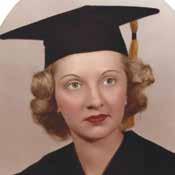
It can be preparation for unlimited opportunities in any field.”

IN 1949, DOROTHY PRICE (formerly Gracz) graduated from the School of Engineering and Applied Sciences with a degree in industrial engineering, making her the first female student to graduate from the University at Buffalo with an engineering degree.
Price, who passed away in 2008, began her journey in engineering with an aircraft engineering and drafting course at Cornell University. During World War II, she was recruited to work at the Curtis-Wright Corporation as an engineer’s aid, helping engineers make corrections on blueprints for cargo and fighter planes. Price’s aptitude for the job prompted her boss to encourage her to study engineering after the war ended.
While the significance of her achievement continues to draw acclaim, Price’s son, Jim Moynihan, noted that his mother would often say, “I was the first, but there were others,” acknowledging four other female students who enrolled in SEAS during her time as an undergraduate.
According to Moynihan, Price helped start a chapter of the Society for Advancement of Management at SEAS, one of the school’s first student engineering clubs, and was elected to serve as secretary.
After graduating, she worked in industry for several years before pursuing a career as a physics teacher.
In 1999, Price returned to UB to receive the Vital Partners Award, commemorating the 50th anniversary of her graduation and recognizing her as a role model for future generations of women in engineering.
When accepting the award, she encouraged women with an interest in math and the sciences to pursue engineering, saying, “It can be preparation for unlimited opportunities in any field.”

IN THE SUMMER OF 2014, first-year student Parveen Attai received an invitation to move to campus early and join the first cohort of a new group called Women in Science and Engineering (WiSE). Attai, now a medical student at the University at Buffalo, was excited for the opportunity to receive a system of support before stepping foot on campus.
Today, WiSE supports hundreds of students like Attai each year with the continued goal of improving the recruitment, retention and success of women in STEM fields. Over the past decade, WiSE has expanded in both resources and the number of impactful programs that it offers. Since the program ’ s inception, the percentage of women enrolled in SEAS has risen by 36%.
A collaboration between the School of Engineering and Applied Sciences and the College of Arts and Sciences, WiSE provides workshops, events and lectures; student ambassador and mentorship programs; and networking opportunities for UB students of all genders in STEM fields.
“WiSE gives us a space to meet and chat with people doing the same things,” said PhD student Jasmine Epps, a WiSE student ambassador and outreach mentor who graduated with a bachelor’s degree in biomedical engineering in May
“It was really comforting to meet other women in STEM. I knew the numbers, but now I was living the numbers,” Epps continued, noting that in her first lab, only two out of the 35 students were female. Through WiSE events, she met one of her closest friends and even received an internship offer while speaking with a UB alum.


It was really comforting to meet other women in STEM. I knew the numbers, but now I was living the numbers.”
Jasmine Epps (BS ’24)
TOP: FEMALE STUDENTS ENGAGE IN DISCUSSION AT A WISE EVENT BOTTOM: A GROUP OF STUDENTS GATHER DURING THE FIRST YEAR OF THE WISE EARLY MOVE-IN PROGRAM.


By Elizabeth Egan
ADOPTING A DOG is not a typical factor that a person considers when choosing a college—unless they have big sisters.
JACKIE, LEFT, AND COLLEEN, RIGHT, BRONNER PICTURED AT MACHU PICCHU IN PERU, TOP, AND ON A HIKE WITH THEIR DOG MURPHY, BOTTOM. PHOTOS COURTESY OF COLLEEN AND JACKIE BRONNER.
Jackie Bronner (BS ’14), the youngest of three sisters, was torn between engineering schools on opposite sides of the country Her sister, Samantha Bronner, was working in Seattle as an engineer at Boeing, while her oldest sister, Colleen Bronner (PhD ’14, BS ’05), was returning to the University at Buffalo to pursue her PhD in environmental engineering. Both Samantha and Colleen wanted their youngest sibling to live nearby
The deciding factors for Jackie came down to UB’s strong civil engineering program and Colleen’s
promise to get a dog. Jackie moved to Buffalo and Colleen adopted a Border Collie mix named Murphy
SAME SCHOOL—DIFFERENT DECADE
Eleven years before Jackie’s big decision, Colleen made the choice to attend UB.
Although Colleen’s aptitude for math and science had attracted her to engineering, she was unsure if she wanted to stick with it. She considered quitting engineering during her sophomore year until she took “Introduction to Environmental Engineering.”
“In that course, I started to connect what I was learning to what I ultimately wanted to do: Make a difference in the world,” said Colleen, who now


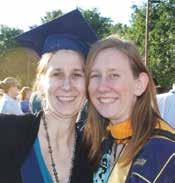
teaches the same course at the University of California, Davis.
She earned her bachelor’s degree in environmental engineering and later returned to UB to pursue a PhD in environmental engineering with a concentration in stream restoration.
Following in the direction of her older sisters, Jackie also pursued engineering. However, it was her dad who most influenced her interest in civil engineering.
“My dad worked in construction, so that was something I felt familiar with,” said Jackie. “I like to build things and see what I am working on.”
During her junior year, Jackie grew interested in geotechnical engineering and received immense support from former UB faculty member Christine Human.
“She helped set me up with an internship where she had done a portion of her career, and she was really supportive when I thought about grad school for geotech,” said Jackie.
While both sisters had busy schedules, they found time to spend with each other and Murphy, whether at Colleen’s graduate student office or taking Murphy on walks around Buffalo. Murphy would also spend time with Jackie and her friends, serving as their designated “therapy dog” and getting dressed up in orange to serve as the civil engineering mascot for the program’s annual soccer game against the environmental engineering students.
In a special moment for the Bronner family, Colleen and Jackie together joined UB’s graduating class of 2014.
Following graduation, Jackie enrolled at UC Davis to pursue a master’s degree in geotechnical engineering, and Colleen joined California State University, Chico as an assistant professor of civil engineering.
When Jackie heard that her department was looking to add environmental engineering faculty, she mentioned to her professors that Colleen was interested. A few days later, Colleen received an invitation to apply and soon, once again, the sisters were sharing a school.
“She might have been at Buffalo first, but I was at Davis first,” joked Jackie.
Jackie has finally joined Samantha in Seattle as a geotechnical engineer, where she has overseen safety efforts for projects ranging from skyscrapers to dams.
“It was great to move to a new city and still know that I had a piece of home there,” Jackie noted.
She currently works for the city of Seattle, helping write and enforce building codes.
“I can point out buildings in the Seattle skyline that were my buildings,” said Jackie. “I worked on the Amazon buildings downtown and on the Microsoft campus. It is always fun to drive people around and point out my work to feel like I have a little part of the city.”
While Jackie can see the power of her UB education reflected in the Seattle skyline, Colleen sees it through the impact she has on her students.
“My time at UB gave me a good model for the environmental engineering program,” said Colleen, adding that the senior design course that she took at UB influenced the senior design program at UC Davis.
With two younger sisters, mentorship is second nature to Colleen, who is now a professor of teaching. In 2023, she received UC Davis’ Women and Philanthropy Impact Award, honoring her efforts to mentor and create sustainable opportunities for women in engineering. She also serves as the faculty advisor for UC Davis’ chapter of Engineers Without Borders, taking teams of aspiring environmental engineers around the world to support clean drinking water and sanitation projects.
Colleen and Jackie’s education and careers have been entwined for years. Only time will tell if their paths reunite again. Murphy still lives happily with Colleen.

I started to connect what I was learning to what I ultimately wanted to do: Make a difference in the world.”
Colleen Bronner (PhD ’14, BS ’05)

BEHIND EVERY EXTRAORDINARY SUCCESS lies a personal narrative woven with guidance, inspiration and unwavering support. For Briana Tom (MBA & BS ’17), her inclusion in Buffalo Business First’s latest 30 Under 30 is both a tribute to her talent and the people who helped shape her path.
Tom, a chemical and biological engineering alum and sales engineer with Harper International Corporation, was among 30 professionals selected from nearly 100 nominations. Among the factors considered for inclusion are career achievements, leadership and community engagement.
At Harper International, Tom provides organizations with engineered solutions for thermal processing of advanced materials like batteries, technical ceramics and carbon fiber. She credits her degrees with helping to shape her life.
“In my role, I work with engineers and MBAs from all over the world from different universities and everyone is always impressed when I tell them where my degrees are from,” Tom says.
Tom also credits her mentors for their guidance in helping her learn and establish goals. Her family’s impact on her life and career are significant, as well.
“This accomplishment is so special to me because it is a tribute to my parents,” Tom says. “My mother immigrated to the U.S. when she was a child, and my father is a first-generation American. It was always drilled into me that we could accomplish anything. Without their sacrifices, I wouldn’t have been able to receive this recognition.”
Tom maintains a connection to UB as secretary of the Engineering and Applied Sciences Alumni Association. She also volunteers on several school committees.
AFTER SEEING HIS BROTHER HAVE A POSITIVE EXPERIENCE as a student at the University at Buffalo, Victor Bahl (MS ’88, BS ’86) decided to follow suit and enroll at UB. It turned out to be a great decision, says Bahl, who used his education as the bedrock for a 27-year career at Microsoft.
Bahl, who earned bachelor’s and master’s degrees in electrical and computer engineering, returned to UB in May to accept the Dean’s Award for Achievement—the school’s highest honor—and to address the graduating class of 2024 at commencement.
Bahl is currently leading a team in building pathways to demonstrate how cloud networks can function just as well, if not better, than typical cellular networks, paving the way for new pathways in the telecom industry.
While the winter temperatures in Buffalo came as a bit of a shock to Bahl, who moved from India, the rewarding experience of his time at UB and his appreciation for the Buffalo Bills and chicken wings more than made up for it.
The world is ready for technology disruptions, and those who think boldly and operate fearlessly will get us to the next level.”
Reflecting on his time at the university, Bahl recalled enjoying a class on communications systems. He has used the foundational skills developed in the class throughout his career and in his current positions as a technical fellow and chief technology officer for Microsoft’s telecom-focused platform, Azure for Operators.
During commencement, he also spoke about confidence and the endless possibilities that come with an engineering degree.
He shared, “The world is ready for technology disruptions, and those who think boldly and operate fearlessly will get us to the next level.”
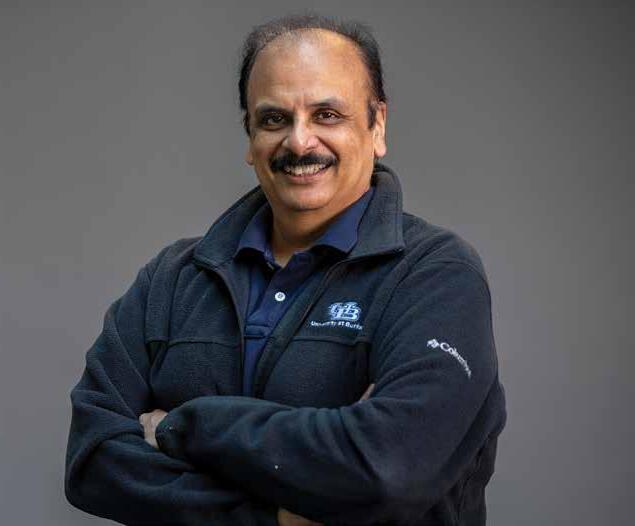
“ENGINEERING IS A ‘GET TO’ JOB,” said Salvatore Privitera (BS ’88), as he addressed a room full of seniors from the School of Engineering and Applied Sciences.
The Engineering and Applied Sciences Alumni Association presented Privitera with the 2024 Engineer of the Year Award during the school’s annual Pledge to Professionalism Ceremony in February, during which students show their commitment to the ethical and moral behaviors required of engineers and computing professionals. The award recognizes a distinguished alum or affiliate of the school.
Privitera spoke at the ceremony and told the students that the combination of skills he gained at UB along with the opportunity to tackle challenges that are of greater importance than himself helped him understand how an engineering degree can be incredibly powerful and could make his life special.
“Ultimately, what engineers do is solve problems,” said Privitera, also an advisory board member for the Department of Biomedical Engineering. “When you couple that ability to solve problems with a problem statement that has import, you create a ‘get to’ job.”
After receiving his bachelor’s degree in mechanical engineering, he started his career as a plastics engineer at Fisher Price. He later joined AtriCure, where he now serves as chief technology officer.
Privitera helped the company grow from a small startup to a public company and led the development of numerous technologies, including the AtriClip, a device used to prevent strokes in patients with the heart condition, atrial fibrillation. In addition to holding over 50 patents, his work impacts 150 million patients each year.

When you couple that ability to solve problems with a problem statement that has import, you create a ‘get to’ job.”
Salvatore Privitera (BS ’88)
SALVATORE PRIVITERA ADDRESSES STUDENTS AT THE SEAS PLEDGE TO PROFESSIONALISM CEREMONY.

DEAN’S ADVISORY COUNCIL MEMBERS
Russell Agrusa (Retired), ICONICS, Inc., Michael Cadigan, GlobalFoundries, Julie Cercone, Citi, Daniel D’Angelo, Applied Research Associates, Dennis Elsenbeck, Phillips Lytle LLP Energy Consulting Services, Mark Glauser, Syracuse University, Karianne Gomez, Genpact, William Harris, Innovation Advisory Partners, Cynthia Hoover, Linde Engineering Americas, Robert Jacoby, Royal Dutch Shell, Joseph Kessler, New York Power Authority, Anna Knight, Linde, Steve Krenzer, Thinkific Inc., Anil Kshirsagar, CAPIOT Software, Inc., Michael Kurdziel, L3Harris Technologies, Gina Lee-Glauser (Retired), Syracuse University, Justina Nixon-Saintil, IBM, Mark Santoro, Raytheon Intelligence and Space, Ashish Shah, Viant Medical, George Small, Moog Inc., Alice Smith, Auburn University, Stephen Still, University at Buffalo, Subbarao Vanka, NW Engineering Consultants, Inc., Chris Wan, Dyno Group, James Wehrfritz (Retired), ExxonMobil Corporation, Candace Yano, University of California, Berkeley, Paul Ameis (Emeritus Member), WTS, Inc., Ronald Benczkowski (Emeritus Member, Retired), Moog, Inc.
PICTURED ABOVE: MEMBERS OF THE DEAN’S ADVISORY COUNCIL TRAVELED FROM ACROSS THE COUNTRY TO MEET WITH SEAS LEADERSHIP AND STUDENTS DURING THE SPRING 2024 MEETING.












TO BECOME A PARTNER, CONTACT KEVIN BURKE AT KMBURKE@ BUFFALO.EDU
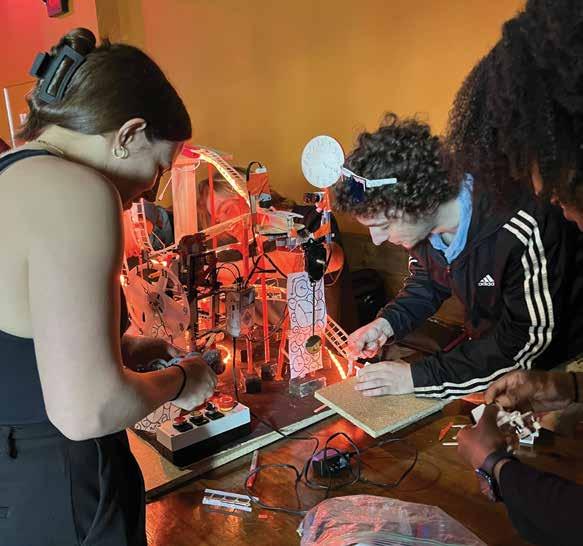
Students compete in theme park attraction design competition
By Elizabeth Egan
STUDENTS IN UB’S THEME PARK ENGINEERING CLUB BUILD A MODEL ATTRACTION FOR THE RIDE ENGINEERING COMPETITION. PHOTO COURTESY OF ALAINA HERMAN.
Katelyn Churakos sped towards the lobby of the Universal Orlando Resort on a mission. Six travel mugs, one for each of her teammates, needed to be refilled before the coffee station closed at 11 p.m.
As she neared the lobby with five minutes to spare, groups of students whom she recognized from the other teams streamed passed, their arms equally filled with mugs. They all had the same idea. They would have time to sleep once the competition was over.
The University at Buffalo’s Theme Park Engineering Club (UB TPEC) loaded up on coffee for the Toronto Metropolitan University (TMU) Thrill Design Competition. The three-day competition, hosted by Universal Creative in Orlando every November, invites student teams to compete in

several challenges judged by industry professionals. UB TPEC was among the 19 teams invited—the first time in club history.
The challenges are unified by a fictional requirement to construct an attraction. Challenges include assignments relating to mechanical design, safety and accessibility, interactive attractions and attraction design.
Led by Alaina Herman (BS ’24), former club president who graduated in May with degrees in mechanical engineering and theater, the UB team was chosen to compete in multiple challenges.
The other students representing UB included Bryan Rambo (BS ’24), who also graduated in May with a degree in computer engineering; Alison Casson, a senior mathematics major and current
club president; Josh Schertzer, a junior computer science major; Franklin Merlo, a junior aerospace and mechanical engineering major; and Churakos, a senior mechanical engineering major and law minor.
Although there are no winners in the competition, the UB team was praised by the judges for their work.
After watching “The Imagineering Story” documentary series on Disney+, Herman knew that her future career was in theme parks. A physics student at SUNY Oswego, Herman decided to transfer to a SUNY school that offered a degree in mechanical engineering. Already home to a theme park engineering club, UB seemed like the ideal choice.
The club meets weekly to discuss the different steps of making an attraction, including mechanical systems, theming and marketing. Herman noted that attractions go beyond just rides to encompass any interactive, immersive or themed experience.
“It can be anything from theme parks, roller coasters, museums, escape rooms and even live theater could be involved. It takes engineers and creatives, so the industry really bridges the gap between technical and creative,” said Herman.
The club also provides numerous opportunities for students to network with industry professionals and travel to various events and competitions.
Preparation for the competition began in the summer of 2023 when the students submitted an attraction design—including a basic control system, marketing strategy and graphics—for the competition’s open qualifying round.
The students held weekly meetings to complete and submit the materials that determined which challenges, if any, they would be invited to enter. Once accepted, they had four months to prepare.
The challenges were announced on the first day of the competition and the students could work wherever and whenever they wanted, including the Universal Theme Parks. The UB team visited the attractions for inspiration before working in their
hotel for the next two days. They worked around the clock, only stopping briefly to eat and sleep.
Each team created a set of deliverables that they presented to the other teams and judges. UB received commendations for their presentation, operational feasibility, technical communication and technology integration.
“The judges on the panel were from different aspects of the industry, so we got different perspectives,” said Merlo, noting that the judges gave feedback on important elements such as staffing, maintenance and accessibility.
With the competition over, the students were free to enjoy the parks. But that did not stop them from continuing to think about engineering.
“It was really fun to analyze the rides once we got to the park,” said Herman. “We got to point out everything we learned from the judges about the park that wasn’t necessarily public information.”
Following graduation, Herman started her career with a year-long project controls and planning internship at Walt Disney Imagineering. She will work on a classic attraction and said that she could not be more excited.
Hagrid’s Magical Creatures Motorbike Adventure, Universal Islands of Adventure
Star Wars: Rise of the Resistance, Disney’s Hollywood Studios
Guardians of the Galaxy: Cosmic Rewind, Disney’s EPCOT
Jurassic World VelociCoaster, Universal Islands of Adventure
Avatar Flight of Passage, Disney’s Animal Kingdom
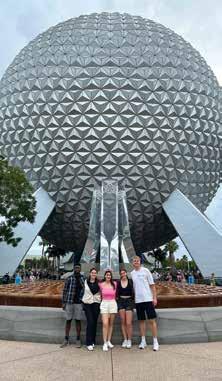
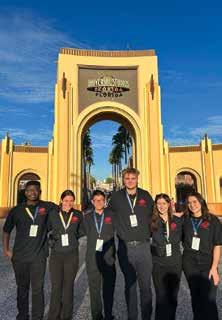
This is a rare occurrence and it’s happening right over our school.”
Richard Magnani, SEDS President
ON APRIL 8, people across North America watched the skies to experience a once-in-alifetime event: a total solar eclipse. Thanks to a 360-degree GoPro camera attached to a weather balloon, however, the UB Students for the Exploration and Development of Space (SEDS) club captured a unique view of the celestial event, unimpeded by the clouds.
The UB community gathered on campus during the university’s viewing event to watch the five-footwide balloon rise over 15 miles into the air.
In addition to capturing stunning video of the eclipse, the project provided the students with experience working through the challenges of high-altitude constraints, below-freezing temperatures and low oxygen.



“This is a rare occurrence and it’s happening right over our school,” said SEDS President Richard Magnani ahead of the launch. “Keeping this project in the UB SEDS spirit of hands-on learning, we’re trying to make everything ourselves, within reason. We’re not making a latex balloon ourselves, but we are sewing our own parachutes, as well as a few other components.”
The following day, the group used GPS to track down the weather balloon to the middle of Seneca Lake, over 100 miles from Buffalo. Although the equipment had drifted in the water for hours, the team miraculously managed to retrieve nearly two hours of footage—albeit with the help of uncooked rice, silica gel and a vacuum chamber to remove water from the camera.
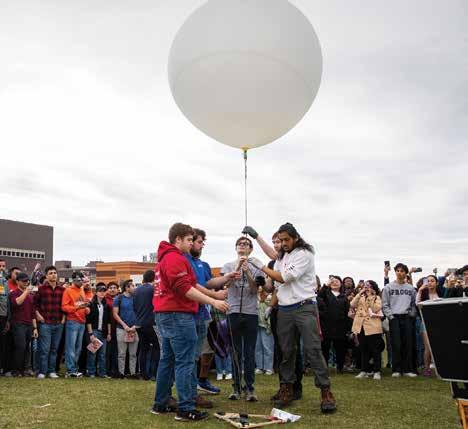

2024 IS A RECORD YEAR for UB’s American Society of Civil Engineers (ASCE) club. The students earned a second-place overall finish at the national Student Steel Bridge Competition—the best finish for the steel bridge team in club history.
During both the regional and national competitions, UB ASCE members were tasked with designing and constructing a scale model steel bridge. Panelists evaluated builds based on construct speed, efficiency and load handling—crucial factors in real-world engineering. The team earned first place in all but one criterion at the regional competition.
“It has been a challenge to design and fabricate a bridge with all of the specified constraints in mind while also considering the importance of a fast build time,” explains project managers Ben Cardamone and Daniella Kata. “We spent so many hours in our lab space and the computer lab working to create the most efficient bridge.”

The second-place finish marks the second consecutive year that the team secured its best finish ever at the national competition, placing third overall in 2023.
UB ASCE’s concrete canoe team earned first place in the display category during the regional competition, and the seismic design team finished 14th out of 45 teams during the Earthquake Engineering Research Institute’s annual competition that welcomed undergraduate organizations across the globe.



This artwork, “Toast to Tomorrow: Cheers to MicroValve Magic,” depicts a 3D-printed microvalve that is smaller than a grain of rice and disguised within the whimsical shape of a champagne flute tower. Created by Aditya Chivate, an industrial engineering PhD student, the image earned a prize for Most Playful Representation of Research in the UB Art of Research competition, which showcases the inherent beauty in scholarship.
One historic campaign, nearly 84,000 donors and more than $1 billion raised Because of the overwhelming generosity of alumni, donors and friends, more UB students will achieve their dreams, and UB will continue changing the world for the better. Learn more at buffalo.edu/campaign.

